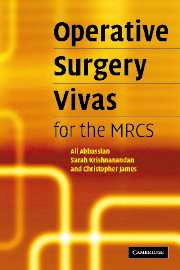Book contents
- Frontmatter
- Contents
- Preface
- 1 The elective repair of an abdominal aortic aneurysm
- 2 Adrenalectomy
- 3 Amputation (below knee)
- 4 Anorectal abscesses, fistulae and pilonidal sinus
- 5 Appendicectomy
- 6 Principles of bowel anastomosis
- 7 Breast surgery
- 8 Carotid endarterectomy
- 9 Carpal tunnel decompression
- 10 Central venous cannulation
- 11 Cholecystectomy (laparoscopic)
- 12 Circumcision
- 13 Colles' fracture (closed reduction of)
- 14 Compound fractures
- 15 Dupuytren's contracture release
- 16 Dynamic hip screw
- 17 Fasciotomy for compartment syndrome
- 18 Femoral embolectomy
- 19 Femoral hernia repair
- 20 Haemorrhoidectomy
- 21 Hip surgery
- 22 Hydrocele repair
- 23 The open repair of an inguinal hernia
- 24 Laparotomy and abdominal incisions
- 25 Oesophago-gastroduodenoscopy
- 26 Orchidectomy
- 27 Parotidectomy
- 28 Perforated peptic ulcer
- 29 Pyloric stenosis and Ramstedt's pyloromyotomy
- 30 Right hemicolectomy
- 31 Skin cover (the reconstructive ladder)
- 32 Spinal procedures
- 33 Splenectomy
- 34 Stomas
- 35 Submandibular gland excision
- 36 Tendon repairs
- 37 Thoracostomy (insertion of a chest drain)
- 38 Thoracotomy
- 39 Thyroidectomy
- 40 Tracheostomy
- 41 Urinary retention and related surgical procedures
- 42 Varicose vein surgery
- 43 Vasectomy
- 44 Zadik's procedure
32 - Spinal procedures
Published online by Cambridge University Press: 16 October 2009
- Frontmatter
- Contents
- Preface
- 1 The elective repair of an abdominal aortic aneurysm
- 2 Adrenalectomy
- 3 Amputation (below knee)
- 4 Anorectal abscesses, fistulae and pilonidal sinus
- 5 Appendicectomy
- 6 Principles of bowel anastomosis
- 7 Breast surgery
- 8 Carotid endarterectomy
- 9 Carpal tunnel decompression
- 10 Central venous cannulation
- 11 Cholecystectomy (laparoscopic)
- 12 Circumcision
- 13 Colles' fracture (closed reduction of)
- 14 Compound fractures
- 15 Dupuytren's contracture release
- 16 Dynamic hip screw
- 17 Fasciotomy for compartment syndrome
- 18 Femoral embolectomy
- 19 Femoral hernia repair
- 20 Haemorrhoidectomy
- 21 Hip surgery
- 22 Hydrocele repair
- 23 The open repair of an inguinal hernia
- 24 Laparotomy and abdominal incisions
- 25 Oesophago-gastroduodenoscopy
- 26 Orchidectomy
- 27 Parotidectomy
- 28 Perforated peptic ulcer
- 29 Pyloric stenosis and Ramstedt's pyloromyotomy
- 30 Right hemicolectomy
- 31 Skin cover (the reconstructive ladder)
- 32 Spinal procedures
- 33 Splenectomy
- 34 Stomas
- 35 Submandibular gland excision
- 36 Tendon repairs
- 37 Thoracostomy (insertion of a chest drain)
- 38 Thoracotomy
- 39 Thyroidectomy
- 40 Tracheostomy
- 41 Urinary retention and related surgical procedures
- 42 Varicose vein surgery
- 43 Vasectomy
- 44 Zadik's procedure
Summary
What are the common surgical approaches to the spine?
Posterior approaches These can be midline approaches over the spinous processes with retraction of the paraspinal muscles from the lamina using a cobb retractor. This gives good access to the posterior elements of the cervical, thoracic and lumbar spine. It is commonly used for lumbar discectomy, laminectomy and for posterior spinal instrumentation as it gives an easy route to the lamina and the pedicles.
A costotransversctomy approach provides a posterolateral approach to the thoracic spine through which the lateral aspect of the vertebral body and the anterior aspect of the spinal cannal are reached without the need for a thoracotomy.
A transpedicular approach refers to creating a tunnel within the pedicle to allow access to the anterior elements.
A paraspinal or wiltse approach is a posterolateral approach to the lumbar spine that utilises the plane between the multifidus and longissimus muscles. This allows access to far lateral disc herniations without the need to resect joints.
Anterior approaches Anterior cervical approach, medial to sternocleidomastoid muscle, retracting the carotid sheath laterally and the trachea and the oesophagus medially, allows good access to the cervical spine as well as the T1 verteral body.
A thoracotomy (usually a left lateral thoracotomy) is used to
access the T3—T12 vertebral bodies anteriorly. Anterior exposure of T2 and T3 vertebra is difficult, and options include a third-rid thoracotomy or a midline sterotomy.
A transdiaphragmatic thoracolumbar approach is used to access the anterior aspect of the thoracolumbar junction (T10L2). The anterior aspect of the lumbar spine is accessed through abdominal incisions. This can be extra- or transperitoneal.
- Type
- Chapter
- Information
- Operative Surgery Vivas for the MRCS , pp. 119 - 122Publisher: Cambridge University PressPrint publication year: 2006



